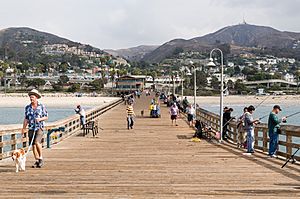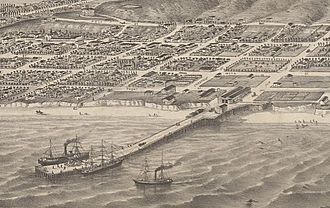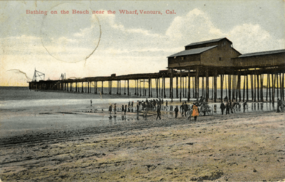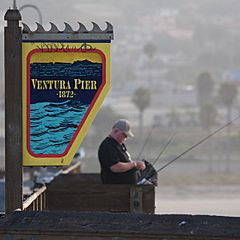Ventura Pier facts for kids

Ventura Pier with fishermen, 2013
|
|
| Type | Fishing pier |
|---|---|
| Spans | Pacific Ocean |
| Locale | Ventura, California, U.S. |
| Construction | Douglas fir (pilings and deck) |
| Owner | City of Ventura |
| Total length | 1,600 ft (490 m) |
| Width | 25.5 to 67.66 ft (7.77 to 20.62 m) |
| Opening date | 1872 |
| Coordinates | 34°16′27″N 119°17′29″W / 34.2741°N 119.2915°W |
| Ventura Historic Landmark No. 20 | |
The Ventura Pier is a famous wooden pier in Ventura, California. It stretches out into the Pacific Ocean. This pier is also known as Ventura Historic Landmark No. 20. It holds a special record as the oldest pier in all of California!
The pier was first built way back in 1872. For many years, it was a busy place for ships. They brought goods like lumber to the area and took away farm products and oil. Today, the pier is no longer used for trade. Instead, it's a popular spot for fishing and walking. You can enjoy amazing views of Ventura and the Channel Islands from here.
Over the years, the pier has faced many challenges. Storms, big waves, and even a ship collision in 1914 have damaged it. From 1938 to 1995, it was the longest wooden pier on the California coast. It measured 1,958 feet (597 meters) long! Today, the pier is 1,600 feet (490 meters) long. It's a key spot for tourists, families, and fishers every day.
Contents
Fun Things to Do at Ventura Pier
The City of Ventura owns and takes care of the Ventura Pier. The city bought the pier in 1993 from the State of California. Before that, different groups and even private owners managed it.
There are many cool activities you can enjoy at the pier:
- Fishing Adventures: You can fish right from the pier deck! People often catch fish like jacksmelt, mackerel, and perch. You might even see sand sharks or stingrays. There are cleaning stations along the pier for your catch. The best part? You don't need a fishing license to fish from the pier! Just remember to check the signs for rules about fish size and types.
- Amazing Views and Walks: The pier is perfect for walking, jogging, or even bicycling. You'll get fantastic views of Ventura City and the Channel Islands National Park. Look for Anacapa and Santa Cruz Islands in the distance. You can also see Surfers Point, the Santa Barbara Channel, and the Topatopa Mountains. In the evening, the sunsets are beautiful, and it's a great spot for stargazing.
- Learn About History and Nature: Along the pier, you'll find special signs called interpretive panels. These panels share interesting facts about the pier's history. They also tell you about local marine animals, birds, the Channel Islands, and the Chumash Indians. The pier also has benches to rest and restrooms.
- Food and Fun: If you get hungry, there are places to eat right on the pier. You can find a seafood restaurant called Eric Ericsson's Fish Co. There's also a brewery called Madewest and a taco shack called Beach House Tacos.
- Nearby Attractions: The pier is next to San Buenaventura State Beach. It's also near the Omer Rains Coastal Bikeway, a path for bikes. At the base of the pier, you'll find a playground on the west side. On the east side, you can rent bicycles, surreys (a type of bike for multiple people), and other beach gear.
A group called Pier Into The Future helps keep the pier in great shape. They raise money to make sure the pier stays beautiful and safe for everyone.
A Look Back at the Pier's History
Building the Pier
In 1871, people in San Buenaventura (now Ventura) decided they needed a wharf. A wharf is like a pier, but it's mainly for ships to load and unload goods. Joseph Wolfson and Juan Camarillo were key leaders in this project. They wanted the wharf to help their city grow and become more important.
On May 18, 1872, the very first wooden post, called a piling, was driven into the ground. Arcadia Camarillo, Joseph Wolfson's wife, broke a bottle of wine over it in a special ceremony. The wharf was finished quickly, just five months later, on October 5, 1872. Everyone was excited! The local newspaper said it was a "grand improvement" for shipping and travel.
In 1886, an oil pipeline was built to the wharf. This allowed oil from nearby fields to be loaded onto ships and sent to San Francisco. Before railroads arrived in 1887, getting to Ventura by land was hard, especially when rivers flooded. So, ships at the wharf were a main way for people to travel to and from the city.
In its early days, the pier was known as the Ventura Wharf. It was a busy commercial hub. Ships carried farm products and crude oil from local fields. For example, in 1898, the Ventura Wharf Company reported shipping huge amounts of oil, beans, corn, barley, oranges, and lemons.
Storms, Ships, and Repairs
The pier has faced many challenges over the years. Strong storms, ship accidents, and even fires have damaged it.
- In 1877 or 1878, storms damaged the wharf, but it was fixed within weeks.
- On June 25, 1889, a steamer called the W. L. Hardison caught fire at the wharf. A cook accidentally spilled burning fat. The ship was carrying 2,000 barrels of oil and was completely destroyed. Luckily, the crew escaped safely.
- On December 19, 1914, another ship, the Coos Bay, crashed into the wharf. A strong tide pushed it hard against the pilings. The ship then swung under the wharf, hitting it repeatedly with big waves. This caused a lot of damage to the pier.
- On February 13, 1926, a powerful winter storm destroyed a large part of the wharf. Sadly, an accountant named George Proctor was on the pier when it collapsed. He was lost in the water.
- In December 1934, heavy waves caused another section of the pier to collapse.
The Pier for Fishing and Fun
After being damaged in a 1937 winter storm, the pier was rebuilt. It reached its longest size ever, 1,958 feet (597 meters). At this length, it was the longest wooden pier in California!
Even after being rebuilt, the pier continued to suffer from storms and big waves:
- On November 27, 1947, the old Coos Bay ship, which had been buried near the pier since 1914, was dug up by the sand. It washed ashore again, causing more damage.
- On April 22, 1950, the pier reopened after being closed for months due to storm damage. To celebrate, members of the Ventura County Boat Club dressed up as Indian medicine men. They performed a ritual hoping for good fishing!
- In 1976, the pier was officially named Ventura Historic Landmark No. 20.
- In 1977 and 1978, more winter storms damaged the pier. It closed for repairs, costing over $163,000.
- In January 1983, winter storms again damaged the pier. The last 600 feet (180 meters) were closed off. Repairs cost $100,000.
- In 1986, storms damaged the pier once more, and it closed for two years. It reopened in July 1988, but a section of about 400 feet (120 meters) remained closed.
In October 1993, the pier reopened after a big $3.5 million renovation. It got a new deck and a cool "Wavespout" sculpture. This sculpture sprayed seawater as waves rolled by! At this time, it was still California's longest wooden pier.
However, more bad luck struck. In December 1994 and January 1995, heavy waves knocked out over 20 pilings. Then, on December 13, 1995, a storm tore off about 420 feet (130 meters) of the pier. With this loss, it was no longer the longest wooden pier in California. The "Wavespout" sculpture was also lost in the storm.
After the 1995 storm, the city decided not to rebuild the pier to its old length. On April 1, 2000, the pier reopened after a $2.2 million renovation. This time, it had stronger, steel-reinforced pilings and a new octagonal (eight-sided) section at the end. Its current length is 1,600 feet (490 meters).
Recently, the winter storms of 2022–2023 caused serious damage to the pier. A large part of it had to be closed for safety reasons.
Images for kids
See also















